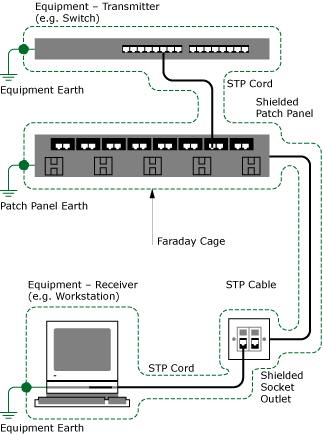
Shielding and earthing (grounding) must be complete
to create an effective shielded cabling system.
Shielded Cabling
Limiting electromagnetic interference (EMI)
A shielded cabling system will produce less electromagnetic emissions than an unshielded system and be less susceptible to external electromagnetic interference. Using protocols employing differential signalling over balanced cabling (100BASE-TX, for example) and network equipment conforming to EMI regulations, concerns over emissions from cabling systems have been minor in recent years.
Time to shield?
With the advent of 10 Gigabit Ethernet over twisted pair media, shielded cabling systems are becoming attractive as a means of addressing the problems of alien crosstalk. Shielding can provide a high degree of confidence that transmission will not be adversely effected by alien crosstalk - when compared with an unshielded system of otherwise equivalent specification.

Shielding and earthing (grounding) must be complete
to create an effective shielded cabling system.
Advantages over unshielded include:
|
Disadvantages over unshielded include:
|
 |
Cable types
Shielded cables come in different forms. Screened twisted pair (ScTP) or foiled twisted pair (F/UTP) has the addition of a foil shield and drain wire over unshielded twisted pair (UTP). Shielded twisted pair (STP) cables have additional shields for each pair. |